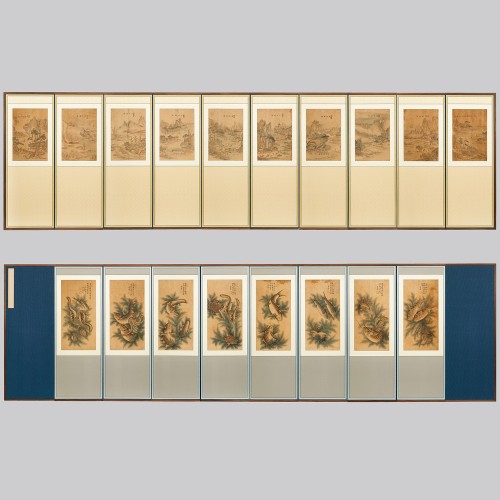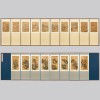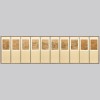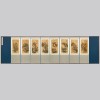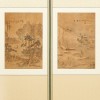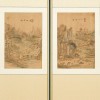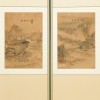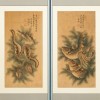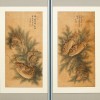본문
조선시대에 제작된 소상팔경도(瀟湘八景圖) 10폭과 어해도(魚蟹圖) 8폭으로 구성된 병풍입니다. 앞 폭에는 소상강 일대 경관이, 뒷 폭에는 다양한 수중 생물이 묘사되었습니다.
앞 폭에는 중국 후난성(湖南省) 소수(瀟水)와 상강(湘江) 일대 풍경을 주제로 한 여덟 가지 경치인 소상팔경(瀟湘八景)을 담았습니다. 밤비 내리는 모습, 안개 낀 절, 물가의 돛단배 등 자연의 변화 속 정취와 전원적 이상이 드러납니다. 오른쪽부터 두번째 폭이 동정추월(洞庭秋月), 세번째 폭이 소상야우(瀟湘夜雨), 네번째 폭이 연사모종(煙寺暮鐘), 다섯번째 폭이 산시청람(山市晴嵐), 여섯번째 폭이 어촌낙조(漁村落照), 일곱번째 폭이 원포귀범(遠浦歸帆), 여덟번째 폭이 평사낙안(平沙落雁), 아홉번째 폭이 강천모설(江天暮雪)입니다.
뒷 폭의 게, 새우, 물고기, 문어, 조개, 전복, 자라 등은 각각 수호, 번영, 풍요, 입신, 다산, 장수 등 길상적 의미를 지닙니다. 대부분 짝으로 그려져 가정의 화목과 자손 번창을 기원하였습니다. 또한, 눈꺼풀이 없는 물고기는 학문에 대한 끊임없는 정진을 상징하기도 합니다. 각 폭 상단에는 자연의 정취를 읊은 한시와 인장이 새겨져 품격이 더해졌습니다.
이러한 병풍은 주로 경사스러운 자리에 사용되었으며, 번영과 평온한 삶에 대한 염원을 담은 길상화입니다.
此为朝鲜时代制作的屏风,包含了描绘潇湘八景的10扇画面和描绘鱼蟹图的8扇画面。屏风的前半部分描绘的是潇湘江一带的自然景观,后半部分则展现了各种水中生物的形象。
正面描绘了中国湖南省潇水和湘江流域八处著名景色,即“潇湘八景”。画中呈现了夜雨、晨雾、寺钟、江舟等景象,在自然变幻中体现出宁静幽远的田园理想。从右数第二扇为“洞庭秋月”,第三扇为“潇湘夜雨”,第四扇为“烟寺暮钟”,第五扇为“山市晴岚”,第六扇为“渔村落照”,第七扇为“远浦归帆”,第八扇为“平沙落雁”,第九扇为“江天暮雪”。
背面描绘了螃蟹、虾、鱼、章鱼、贝类、鲍鱼、甲鱼等水生生物,它们分别象征着守护、繁荣、富饶、立身出仕、多子多孙与长寿等吉祥寓意。这些生物多以成双成对出现,寓意家庭和睦、子嗣昌盛。此外,没有眼睑的鱼象征着对学问不懈的追求。每一扇画面上方还题有咏叹自然意境的汉诗,并钤印以增其雅趣。
这类屏风通常用于庆贺吉事,作为寓意繁荣与平和生活愿望的吉祥绘画作品。
━━━━━
This folding screen consists of ten panels depicting the Eight Views of Xiaoxiang (瀟湘八景圖) on the front and eight panels of Fish and Crustacean Paintings (魚蟹圖) on the back, produced during the Joseon Dynasty. The front panels illustrate the landscapes around the Xiaoxiang River, while the back panels depict various aquatic creatures.
The front panels feature the Eight Views of Xiaoxiang, which portray the scenic landscapes along the Xiaoshui (瀟水) and Xiangjiang (湘江) rivers in Hunan Province, China. These scenes capture the beauty and pastoral ideals of nature, such as sailboats on riverbanks, temples shrouded in mist, and autumn rains. From the right, the second panel depicts Dongting Autumn Moon (洞庭秋月), the third Night Rain on the Xiaoxiang (瀟湘夜雨), the fourth Evening Bell from a Mist-Shrouded Temple (煙寺暮鐘), the fifth Mountain Market in Clearing Mist (山市晴嵐), the sixth Fishing Village in Sunset Glow (漁村落照), the seventh Returning Sails from a Distant Shore (遠浦歸帆), the eighth Wild Geese Descending on a Sandbank (平沙落雁), and the ninth Evening Snow on the River and Sky (江天暮雪).
The back panels feature crabs, shrimps, fish, octopuses, clams, abalones, and soft-shelled turtles, each symbolizing auspicious meanings such as protection, prosperity, abundance, success, fertility, and longevity. Most are depicted in pairs to convey wishes for family harmony and the flourishing of descendants. Additionally, fish without eyelids symbolize relentless pursuit of scholarly achievement. At the top of each panel, poems that evoke the beauty of nature, along with seals, add to the refined elegance of the work.
Such folding screens were primarily used on celebratory occasions and are regarded as auspicious paintings embodying hopes for prosperity and a peaceful life.
